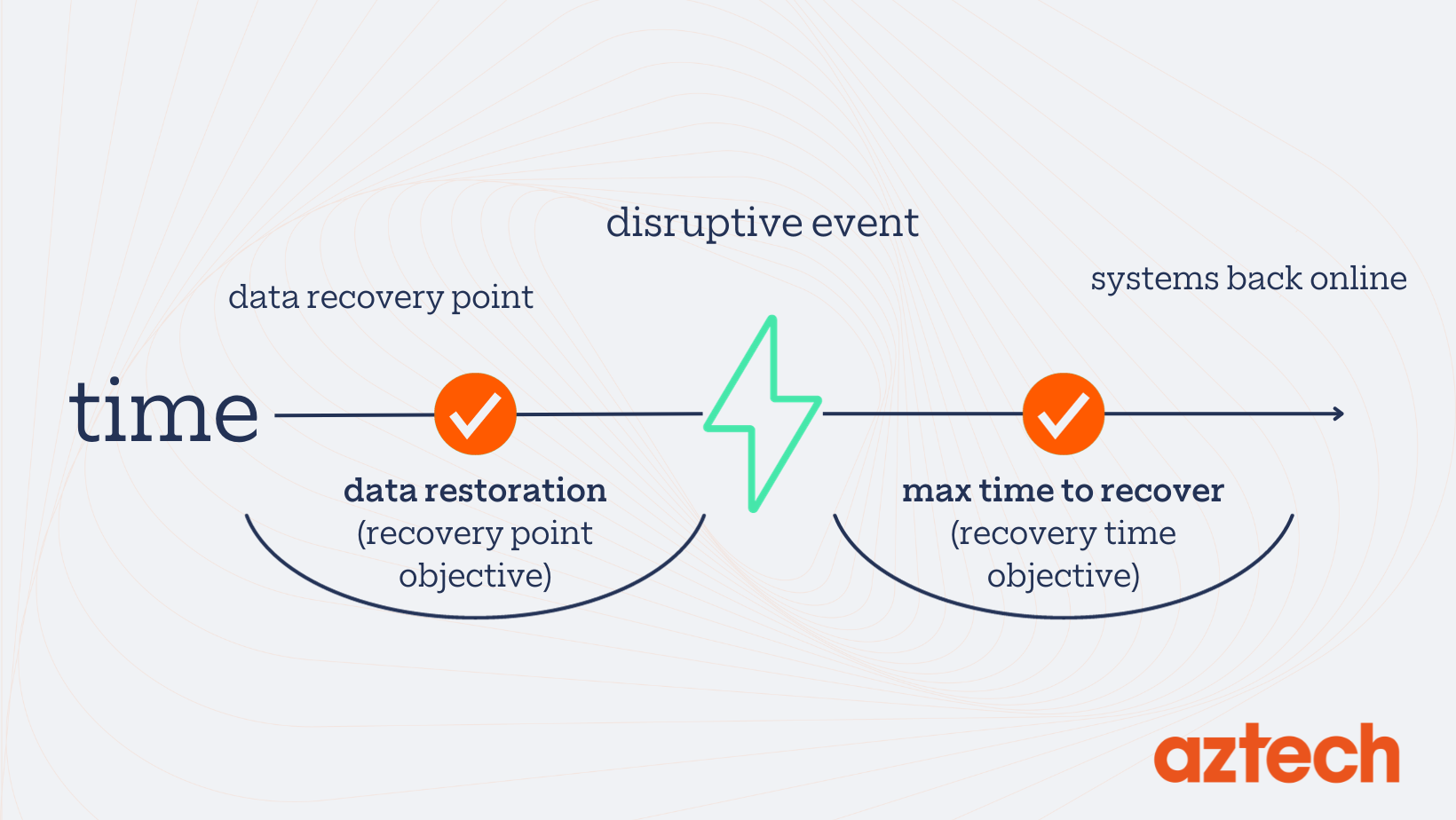Are you familiar with the term recovery point objective (RPO)? If not, you're not alone. Many businesses today are unaware of this important concept of business continuity plan and its relevance in ensuring a successful disaster recovery strategy.
In this blog post, we'll explain everything you need to know about RPOs and give practical advice on how to use them effectively as part of your overall disaster management plan.
Read on for a comprehensive overview of an often overlooked yet critical element in any organisation's data protection strategy!
What is Recovery Point Objective (RPO)?
Recovery Point Objective (RPO) is the point in time from which data must be recovered after a system failure or disaster. In other words, it is the maximum data loss that can occur due to an unexpected event such as a power outage or natural disaster.
For example, in customer chat logs and file servers, let's say your RPO is four hours. This means that you can lose up to four hours of data before it starts having an impact on your business operations.
How Does Recovery Point Objective Work?
RPO works by setting a specific time frame for recovering data from a failed system or disaster event. This time frame is typically measured in minutes, hours, days, or weeks depending on the type of data recovery process and the desired level of protection.
For example, if you were protecting financial transactions with an RPO of one hour, any changes made for data recovery within that hour would need to be recovered if there was a system failure or disaster event.

Benefits of RPO
One of the key benefits of RPO is that it provides organisations with greater flexibility when dealing with system failures and disasters.
By setting an appropriate RPO, organisations can ensure that only the most critical data needs to be recovered in order to maintain business continuity following an incident.
Additionally, RPO can help reduce data loss and data availability, downtime and minimise loss of financial transactions associated with system downtime and natural disasters for an effective disaster recovery planning.
Types of Recovery Point Objectives
There are several different types of Recovery Point Objectives (RPOs) available depending on the type of data being protected and the desired level of protection required.
These include near-time RPOs which provide very short recovery times; mid-time RPOs which provide moderate levels of protection; and long-time RPOs which provide more extensive levels of protection but require longer recovery times.
Considerations When Choosing an RPO
When choosing an appropriate Recovery Point Objective (RPO), businesses should consider factors such as their budget, desired level of protection, acceptable downtime levels for their business, and any applicable regulatory requirements they may have to adhere to when recovering from a disaster event or system failure.
Businesses should also consider whether they have sufficient resources available to meet their chosen RPO should a disaster occur as well as any potential impacts associated with not meeting their chosen objective should an incident occur.
Recovery Point Objective Examples
Data Backup and Restoration
Data backup and restoration is one of the most common recovery point objectives. This involves data backups on a regular basis to ensure that any lost data or corrupted data can be restored quickly and easily.
Depending on the size of the business, this may involve backing up data daily, weekly, or monthly.
Additionally, businesses should also consider storing data in multiple locations in case one location becomes inaccessible due to a natural disaster or other event.
Application Re-installation
Another common recovery point objective is application re-installation. This involves ensuring that any applications used by the business are backed up regularly so they can be reinstalled quickly if needed.
This includes both software applications and web-based applications such as customer relationship management (CRM) systems.
System Hardening
System hardening is another important recovery point objective for businesses to consider. This involves taking steps to secure systems against malicious attacks by implementing security measures such as firewalls, antivirus software, and user authentication protocols.
Additionally, businesses should also consider regularly patching their systems with the latest security updates to ensure their systems remain secure against new threat.
How do you calculate RPO?
Step 1: Identify the Data Loss Tolerance
The first step to calculating RPO is to identify the data loss tolerance of your business. This will be based on how much minimal data loss your business can afford to lose in the event of a disaster.
For example, if you are a financial institution, then you may need to have an RPO of zero, meaning that no critical data loss can occur in the disruptive event.
Step 2: Determine the Frequency of Backups
Once you have identified your data loss tolerance, you will need to determine how frequently backups should be performed in order to meet this tolerance.
For example, if you have an RPO of zero, then backups should be performed on a continuous basis in order to ensure that no data is lost in a disruptive event.
Step 3: Calculate Backup Time and Restore Time
Next, you will need to calculate both the backup time and restore time for each backup job that is being performed.
The back up time is the amount of time it takes for all data to be backed up from its source and stored on a secondary storage device or system.
The restore time is the amount of time it takes for all backed-up data to be restored from its secondary storage device or system back into its original source environment.
Step 4: Calculate Maximum Acceptable Downtime
Once you have calculated both your back up time and restore time, you can then calculate your maximum acceptable downtime (MAD).
This is calculated by subtracting your restore time from your backup time and represents the maximum amount of downtime that your business can tolerate before exceeding its RPO requirement.
Step 5: Calculate Recovery Point Objective
Finally, once you have determined your MAD value, you can then use this value to calculate your Recovery Point Objective (RPO).
This is done by dividing your MAD value by 24 hours (the number of hours in a day) and multiplying it by 100%.
This gives you an RPO value that represents how many hours’ worth of data would be lost if a disaster were to occur at any given point during the day.
Recovery Point Objective vs Recovery Time Objective
Recovery Point Objective
Recovery Point Objective is the maximum data loss a business unit can afford to lose from backup storage in the event of a disaster or other disruption.
RPO is measured in time, and it represents the point in time from which data must be recovered after a disaster.
For example, business units may have an RPO of one hour, meaning that any data lost within the last hour must be restored.
Recovery Time Objective
Recovery Time Objective is the maximum length of time that a business can afford to be without access to its systems and applications after a disaster or other disruption.
Recovery Time Objectives are also measured in time and typically includes both the time it takes to restore data as well as any additional time needed for the business units to resume normal business operations.
Backup Frequency
The frequency with which data backups are taken plays an important role in determining both RPO and RTO.
Backups taken more frequently will allow for shorter RPO and RTO, while backups taken less frequently will result in longer RPO and RTO which are both crucial for business impact analysis.
Business units should consider their specific needs when deciding on a data backup frequency that meets their desired levels of protection.
Cost Considerations
The cost associated with achieving certain levels of protection will vary depending on the type of technology used, such as cloud storage versus local storage, as well as the frequency with which backups are taken.
Businesses should carefully consider both their budget constraints as well as their desired levels of protection before making decisions about their backup strategy.
Testing & Monitoring
Testing and monitoring are essential components of any backup strategy, regardless of whether it utilises cloud storage or local storage solutions.
Regularly testing backups for accuracy ensures that they can be successfully restored when needed, while ongoing monitoring allows organisations to quickly identify potential issues before they become major problems.

-1.png?width=552&height=678&name=text-image%20module%20desktop%20(4)-1.png)


.png?width=2000&name=Case%20study%20(21).png)


-2.png?width=422&height=591&name=text%20image%20tablet%20(31)-2.png)






